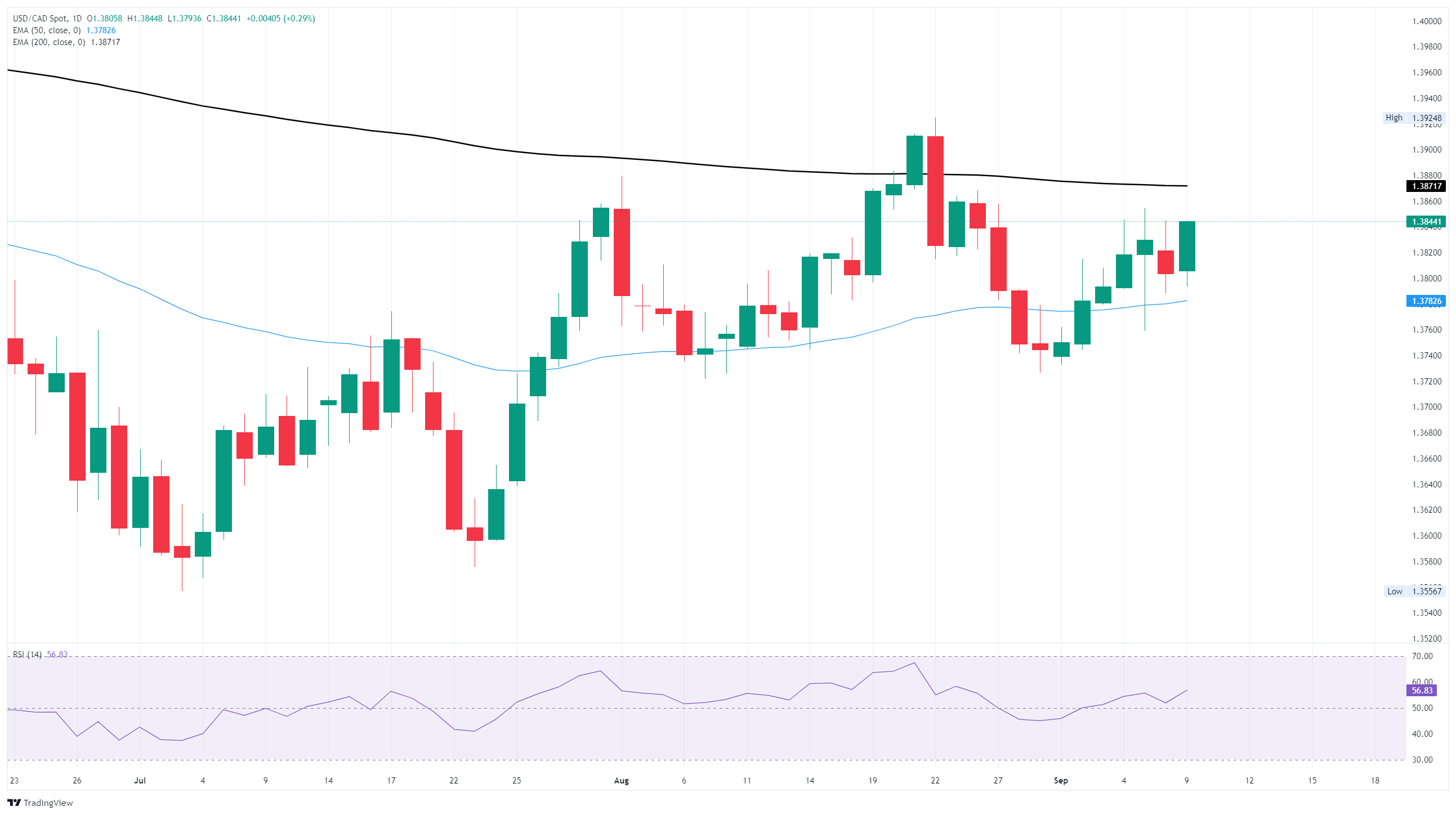Canadian Dollar sinks after NFP revisions drive US Dollar higher
- The Canadian Dollar shed nearly 0.3% against the Greenback on Tuesday.
- US data is driving the broader market as NFP revisions stoke Fed rate cut hopes.
- The US economy added nearly a million jobs fewer than expected during the review period.
The Canadian Dollar (CAD) backslid on Tuesday, driven lower by a general improvement in US Dollar (USD) flows. The Loonie is down over one-quarter of one percent against the Greenback, with the US Dollar Index (DXY) climbing nearly 0.3% on the day for comparison.
US economic data continues to be the main driver behind USD/CAD moves. US Nonfarm Payrolls (NFP) saw their first annual revision this week, with the US economy added around 900K fewer jobs than initially predicted through the revision period that runs March 2024 to March 2025. The final revisions for the annual review window won’t be available until February 2026, but markets believe the Federal Reserve (Fed) has seen enough damage to the US labor market to begin cutting interest rates at their next interest rate call next week.
Daily digest market movers: Canadian Dollar recedes amid rising Fed rate cut bets
- The Canadian Dollar shed 0.3% against the US Dollar on Tuesday.
- Despite remaining within recent technical levels, the Loonie is down over 0.8% against the Greenback from its one-month highs.
- US NFP revisions showed the US economy added 911K fewer jobs than initially forecast in the March-to-March revision window, and further lost hirings could be on the cards as the review period doesn’t include the post-tariff announcement economy.
- Some over-eager market participants are betting that the Fed could deliver a jumbo rate cut on September 17, but a quarter-point rate cut at the minimum appears to be a sure thing.
- This week’s US Consumer Price Index (CPI) inflation print could still stymie Fed rate operations. Headline annual US CPI inflation continues to float well above the Fed’s 2% annual inflation target. Headline CPI inflation for the year ended in August is expected to tick up to 2.9% YoY on Thursday.
Canadian Dollar price forecast: CAD gives up further ground
USD/CAD has risen firmly back above the 1.3800 handle as the Greenback gains further ground against the Loonie. The Canadian Dollar has fallen 0.85% against the US Dollar since its latest August peak that pushed USD/CAD down to 1.3725, and the pair is now heading into steep technical resistance at the 200-day Exponential Moving Average (EMA) near 1.3870.
USD/CAD daily chart

Canadian Dollar FAQs
The key factors driving the Canadian Dollar (CAD) are the level of interest rates set by the Bank of Canada (BoC), the price of Oil, Canada’s largest export, the health of its economy, inflation and the Trade Balance, which is the difference between the value of Canada’s exports versus its imports. Other factors include market sentiment – whether investors are taking on more risky assets (risk-on) or seeking safe-havens (risk-off) – with risk-on being CAD-positive. As its largest trading partner, the health of the US economy is also a key factor influencing the Canadian Dollar.
The Bank of Canada (BoC) has a significant influence on the Canadian Dollar by setting the level of interest rates that banks can lend to one another. This influences the level of interest rates for everyone. The main goal of the BoC is to maintain inflation at 1-3% by adjusting interest rates up or down. Relatively higher interest rates tend to be positive for the CAD. The Bank of Canada can also use quantitative easing and tightening to influence credit conditions, with the former CAD-negative and the latter CAD-positive.
The price of Oil is a key factor impacting the value of the Canadian Dollar. Petroleum is Canada’s biggest export, so Oil price tends to have an immediate impact on the CAD value. Generally, if Oil price rises CAD also goes up, as aggregate demand for the currency increases. The opposite is the case if the price of Oil falls. Higher Oil prices also tend to result in a greater likelihood of a positive Trade Balance, which is also supportive of the CAD.
While inflation had always traditionally been thought of as a negative factor for a currency since it lowers the value of money, the opposite has actually been the case in modern times with the relaxation of cross-border capital controls. Higher inflation tends to lead central banks to put up interest rates which attracts more capital inflows from global investors seeking a lucrative place to keep their money. This increases demand for the local currency, which in Canada’s case is the Canadian Dollar.
Macroeconomic data releases gauge the health of the economy and can have an impact on the Canadian Dollar. Indicators such as GDP, Manufacturing and Services PMIs, employment, and consumer sentiment surveys can all influence the direction of the CAD. A strong economy is good for the Canadian Dollar. Not only does it attract more foreign investment but it may encourage the Bank of Canada to put up interest rates, leading to a stronger currency. If economic data is weak, however, the CAD is likely to fall.

